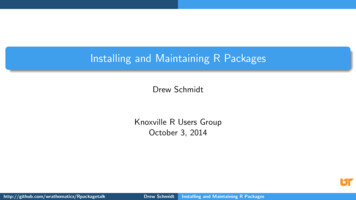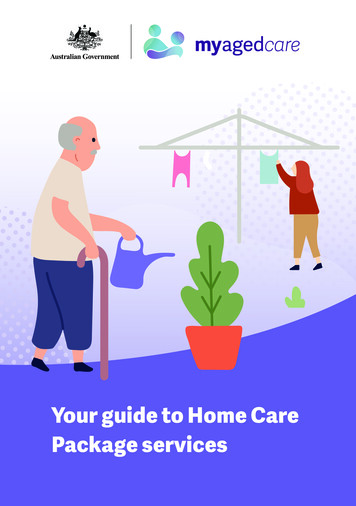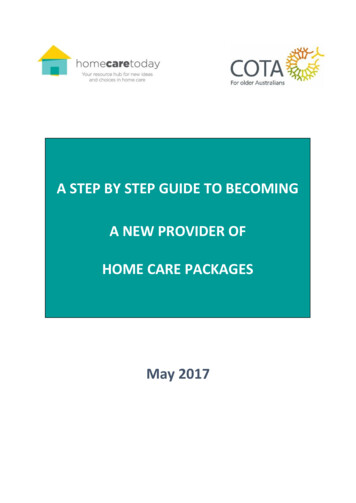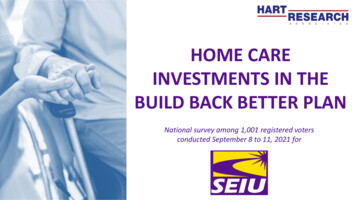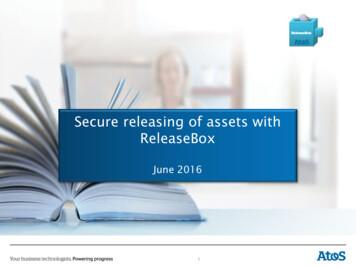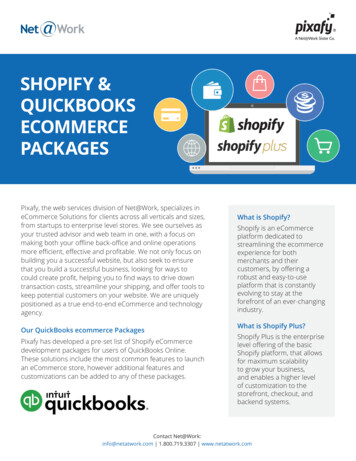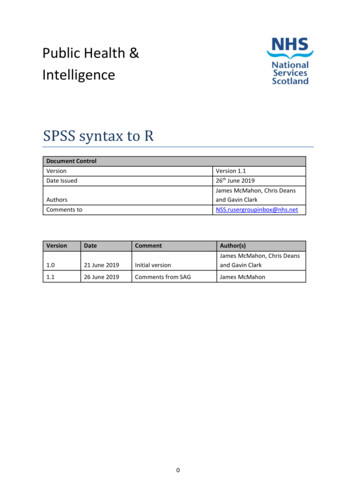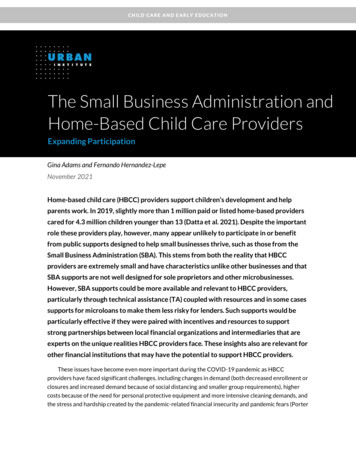
Transcription
Home Care PackagesProgramOperational Manual for Home Care Package consumersVersion 1.2 – September 2021
Contents12Introduction71.1 Helping you stay at home71.2 What does the manual contain?1.3 Who has a role in providing home care?781.4 How will this manual be updated?101.5 Do you have further questions?11The Home Care Packages Program112.1 What is a Home Care Package?2.2 What is the intent of Home Care?11122.3 What is the scope of Home Care?132.4 What is Consumer Directed Care?142.5 How does the Government contribute to the cost of my Home CarePackage?152.6 What is the national priority system?152.7 How does the Home Care Packages Program interact with otherprograms?16342.8 For more information17Your pathway to a Home Care Package203.1 Can I get a Home Care Package?223.2 Registering with My Aged Care223.3 How do I get a comprehensive aged care assessment?233.4 How do I find a home care provider?3.5 How will I be assigned a Home Care Package?27283.6 Your Home Care Agreement30What is my Home Care Package budget?374.1 Your Home Care Package budget374.2 What Government subsidies and supplements are available?384.3 What home care fees will I need to pay?414.4 What costs can be charged by a provider to my package budget?494.5 What is an exit amount?Last updated September 202152Page 2 of 110
54.6 Your monthly statement54What can be included in a Home Care Package?565.1 What can my Home Care Package be used for?565.2 What can’t Home Care Package funds be used for?585.3 What if I want care or services not listed above?615.4 What are unspent funds and how can they be used for care andservices?665.5 Can I make large purchases with my home care package?676Managing your services686.1 Package upgrades686.2 What happens if my package isn’t meeting my needs?696.3 What other programs can I access at the same time as my Home CarePackage?696.4 What happens if I take leave from my Home Care Package?726.5 What other programs can I access if I take leave from my Home CarePackage?74786.6 Can I change providers?746.7 How do I change providers?6.8 What happens to the unspent funds if I change providers75766.9 Ceasing care76Your rights and responsibilities797.1 Charter of Aged Care Rights797.2 Signing the Charter7.3 Your Responsibilities8081Quality in aged care848.1 What can I expect in aged care?848.2 The Aged Care Quality Standards848.3 What can I do if I have feedback about a provider?858.4 What can I do if I have a concern about the care I am receiving? 869Further assistance899.1 What help is available for people with diverse needs?89Last updated September 2021Page 3 of 110
9.2 What assistance is available for my carer(s)?919.3 What other support services are available?9110 What happens if I started my Home Care Package before 1 July 2014? 9310.1 How are my home care fees calculated?9310.2 What happens if I intend to move to a new service provider? 9510.3 What does my Home Care Agreement need if I entered care before1 July 2014?95Researching Home Care Providers – Considerations and checklist97Entering into a Home Care Agreement – Considerations and checklist101Changing Providers – Considerations and Checklist105Setting up a myGov account109Last updated September 2021Page 4 of 110
ReviewDateSummary of changesMarch 2020Manual first issuedFebruary 2021Version 1.1. Updated web links, minor wording changesSeptember 2021Version 1.2. Updated information about Improved Payment ArrangementsDisclaimerThis Manual is designed to provide general guidance to consumers on the HomeCare Packages Program, but is not a substitute for, and is not intended to replacerelevant professional advice or provide any interpretation of the relevant agedcare legislation.Although care has been taken in preparing this Manual, the Commonwealth ofAustralia makes no representations or warranty as to the accuracy, reliability,completeness or currency of the information contained in this Manual. TheCommonwealth of Australia disclaims all and any liability to any person inrespect of anything done by any person in reliance, in whole or part, upon thewhole or any part of this Manual.Last updated September 2021Page 5 of 110
CopyrightCreative Commons Licence - Attribution CC BY 2021 Commonwealth of Australia as represented by the Department of HealthThis publication is licensed under a Creative Commons Attribution 4.0 International Licence galcode (Licence). You must read and understand theLicence before using any material from this publication.RestrictionsThe Licence may not give you all the permissions necessary for your intended use. The Licenceallows you to download and share the publication for free and to use it for any purpose including acommercial purpose. The Licence also allows you to make changes to the publication and to sharethese publicly.The Licence does not cover, and there is no permission given for, use of any of the following materialfound in this publication (if any): the Aged Care Quality Standards diagram, which was developed by the Aged Care Quality andSafety Commission;the Commonwealth Coat of Arms (By way of information, the terms under which the Coat of Armsmay be used can be found at www.itsanhonour.gov.au);any logos (including the Department of Health's logo) and trademarks;any images; andany material belonging to third parties.AttributionWithout limiting your obligations under the Licence, the Department of Health requests that youattribute this publication when you have made changes to it. Any reasonable form of words may beused provided that you: include a reference to this publication and where, practicable, the relevant page numbers;make it clear that you have permission to use the material under the Creative CommonsAttribution 4.0 International Licence;make it clear that you have changed the material used from this publication;include a copyright notice in relation to the material used, using “ 2021 Commonwealth ofAustralia” or a substantially similar notice;to the extent permitted by the Licence, where the material has been changed include a reference“Based on Commonwealth of Australia (Department of Health) material” or a substantially similarreference; anddo not suggest that the Department of Health endorses you or your use of the material.EnquiriesEnquiries regarding any other use of this publication should be addressed to the CommunicationBranch, Department of Health, GPO Box 9848, Canberra ACT 2601, or via e-mail tocopyright@health.gov.auLast updated September 2021Page 6 of 110
1Introduction1.1Helping you stay at homeThe Australian Government funds a range of aged care services delivered inthe community to support senior Australians to live independently in their ownhome for as long as possible. These are: entry level home support – ongoing or short-term entry level servicesprovided under the Commonwealth Home Support Programme; more coordinated support at home - coordinated support packages thataddress your care needs and goals through the Home Care PackagesProgram. There are four levels of packages ranging from low care needs tohigh care needs.You can plan for your future by thinking about your aged care needs andpersonal goals early. Planning ahead improves your ability to liveindependently and to have your wishes respected when the time comes toaccess aged care services. Having these conversations with your family, doctorand other support people will ensure you are better prepared for the future.My Aged Care has further information on how to start planning for your futureaged care needs. The My Aged Care website is www.myagedcare.gov.au.1.2What does the manual contain?This manual is for the Home Care Packages Program, which enablescoordinated support at home. The manual is a part of a suite of informationresources including: ‘Your pathway to accessing a home care package’ brochure; ‘Your guide to Home Care Package services’ booklet; and fact sheets and other information that may be of interest.You can find all of these resources by going to www.myagedcare.gov.au,scrolling to the bottom of the homepage and selecting “Resources” under“Further Information”.This manual has the most detailed information on the Home Care PackagesProgram. It takes you through the Home Care Packages Program from how toaccess a Home Care Package, what costs are involved and the care and supportyou can receive. You can also speak to your provider for more information.Last updated September 2021Page 7 of 110
This manual contains 1800 numbers you can contact for further assistance.Calls to 1800 numbers are generally free when made from a landline. All callsmade from mobile phones are charged at the rates applicable to eachtelephone provider.1.3Who has a role in providing home care?This manual refers to a number of stakeholders that have a role in the agedcare system in Australia. It is important to understand the role everybodyplays.StakeholderRoleConsumerA consumer is a recipient of a Home Care Package.A consumer may also contribute to the cost of theirHome Care Package depending on their financialsituation and the provider they choose.CarerA carer is a family member, friend or other person whoprovides ongoing care and support to you.NominatedrepresentativeA nominated representative is someone who you havegiven permission to: give information on your behalf; and receive information on your behalf.They may be a family member, friend, carer or otherperson. Your representative can be:1. regular or2. authorised.If you are able to give someone consent to speak and actfor you, they can be set up as a regular representative. Aregular representative can speak and act for you, butthey must: get your permission before discussing your personalMy Aged Care information with anyone; and consult you on all decisions and actions they make onyour behalf.Last updated September 2021Page 8 of 110
StakeholderRoleIf you are not physically or medically able to give consentto someone to speak on your behalf, you can set up anauthorised representative.An authorised representative can speak and act for you,but they must: ensure that decisions and actions made on yourbehalf are in your best interest; and keep your personal My Aged Care informationconfidential. They must not disclose your informationto any unauthorised persons.You do not have to have a representative if you do notwant to.My Aged CareMy Aged Care is both a website and a contact centre andthe main entry point to the aged care system inAustralia. My Aged Care aims to make it easier for seniorAustralians, their families, and carers to: access information on ageing and aged care; have their needs assessed; and be supported to find and access services.Aged CareAssessmentTeamAged Care Assessment Teams (ACAT) are teams ofmedical, nursing and allied health professionals. Theyassess your care needs and help you to accessappropriate levels of support. ACATs conductcomprehensive aged care assessments.ACAT are called Aged Care Assessment Services (ACAS) inVictoria.ApprovedprovidersApproved providers deliver aged care in Australia. This isthe organisation that you will interact with the most inmanaging your Home Care Package. Throughout thismanual, approved providers are frequently referred to asproviders.Department ofHealthThe Australian Government Department of Health isresponsible for the policy, funding and administration ofthe aged care system. The Department of Health setsLast updated September 2021Page 9 of 110
StakeholderRolepolicy for the aged care system and provides informationto both yourself and providers in relation to each agedcare program. The Department is also responsible formanaging fraud risk across the programs for which itadministers funding.Services Australia(formerlyDepartment ofHuman Services)The Australian Government Services Australia providesincome assessment services to senior Australians. This isan important step in understanding how much homecare services will cost you. It also administers thepayment system for Home Care Packages. This includespaying approved providers a subsidy on behalf of theDepartment of Health.Department ofVeterans’ AffairsThe Australian Government Department of VeteransAffairs (DVA) conducts aged care income assessments foreligible veterans, their partners and war widow(er)s whoreceive a relevant entitlement. Once the level ofassessable income for aged care is assessed by DVA, thisinformation is provided to the Services Australia who willadvise you of the outcome of the assessment and thehome care fees you may be asked to pay.DVA also provides home care services to eligible veteransand their families.Aged CareQuality andSafetyCommissionThe role of the Aged Care Quality and Safety Commission(Commission) is to protect and enhance the safety,health, well-being and quality of life of people receivingaged care. The Commission independently accredits,assesses and monitors aged care services subsidised bythe Australian Government. The Commission alsoresponds to feedback and complaints received aboutapproved providers. For more information on making acomplaint, you can read Section 8.2 of this manual.1.4How will this manual be updated?The Department of Health will use their best endeavours to keep this manualup to date and accurate. Please use the online version of the manual locatedLast updated September 2021Page 10 of 110
on the My Aged Care website. You can find this manual by visiting this me-care-packages-manualpdf.1.5Do you have further questions?If you have further questions you can call the My Aged Care contact centre on1800 200 422.2The Home Care Packages ProgramThis section describes a Home Care Package, Consumer Directed Care (CDC)and the national priority system. It also helps you understand how the HomeCare Packages Program relates to other aged care programs, and what to do ifyou have hearing or speech difficulties, or need a translator.2.1What is a Home Care Package?A Home Care Package provides coordinated care and services that help seniorAustralians to live safely and independently in their own home for as long as itis safe and appropriate to do so. After you are assessed as needing a HomeCare Package you will be placed in the national priority system. Once you areassigned a package, you need to find a home care provider who will work withyou to: choose care and services that best meet your assessed needs andpersonal goals; and allow you to self-manage your care and services (if you choose to).Last updated September 2021Page 11 of 110
There are four levels of Home Care Packages to help meet the different levelsof care needs:Packages of aged care services forpeople with:Level four: high-level care needsLevel three: intermediate care needsLevel two: low-level care needsLevel one: basic care needsTransitionEntry level, short-term or ongoing supportservices through the Commonwealth HomeSupport ProgrammeTo get a Home Care Package, you need a comprehensive aged careassessment. This is done by an Aged Care Assessment Team (ACAT). Duringyour assessment, your assessor will discuss your current care needs andsupports. They will decide the best level of Home Care Package for you.2.2What is the intent of Home Care?The intent of the Home Care Packages Program is to provide coordinated careand services that help senior Australians to live safely and independently intheir own home for as long as it is safe and appropriate to do so. In the HomeCare Packages Program, you will work together with your provider to design apackage of aged care services that is best and most appropriate for you as anindividual. ‘Dignity of risk’ is at the centre of home care, and means that youhave freedom to make choices for yourself and to guide your care, if youwould like to.A Home Care Package is not extra income that can be used for everyday itemsand costs.Last updated September 2021Page 12 of 110
The Government funding is intended to help meet your assessed care needs soyou can continue to live independently in your home for as long as it is safeand appropriate.The Government is committed to improving the Home Care Program. From 1September 2021 the Government is changing the way the provider of yourHome Care Package is paid. These changes will provide you with a clearerpicture of your home care package and unspent funds. Providers will be paidonly for the care and services they actually delivered to you. This means that,the maximum amount of your package will go towards supporting you toremain in your own home for as long as possible, or will be held for you byGovernment until you need it.You are encouraged to work with your provider to determine how the moneyis spent.2.3What is the scope of Home Care?The main categories of care and services you can get from a Home CarePackage are:CategoryServicesServices to keep you welland independent Personal care.Nursing.Allied health and therapy services.Meal preparation and diet.Specialised support.Services to keep you safein your home Nursing assistance.Home maintenance.Minor home modifications.Goods, equipment and assistivetechnology.Services to keep youconnected to yourcommunity Transport. Social support.These care and services do not replace other health programs that you mightbe eligible for. You should continue to access these if and when you needthrough your general practitioner (GP) and hospitals. A Home Care PackageLast updated September 2021Page 13 of 110
should not be used for care and services that can be accessed through otherhealth programs. Other health programs include the Medical Benefits Scheme(MBS) and the Pharmaceutical Benefits Scheme (PBS).There is more information on what can and cannot be included in a Home CarePackage at Section 4 of this manual.2.4What is Consumer Directed Care?Through your Home Care Package, you have flexibility and choice in thedelivery of your care and services. This means you (and your carer, ifappropriate) have more choice and control over what, when and whereservices are delivered. Your Home Care provider must work in partnershipwith you to design and deliver services that meet your assessed needs andpersonal care goals.Consumer Directed Care means:You get more say inthe care and servicesyou receiveYou work with yourprovider to developyour individual careplan based on yourgoalsYou get more say inhow the care isdelivered and whodelivers it to you (ifyour provider canundertake yourrequests)You haveconversations aboutyour care needs andgoalsYou know how yourpackage is fundedand how your homecare package budgetis spent through yourmonthly statementsYour provider willwork with you toensure that yourpackage continues tomeet your needs bymonitoring you andreviewing your careplanLast updated September 2021Page 14 of 110
You and your provider will agree on: how much you want to be involved in managing your Home CarePackage; the Home Care Package budget available to provide your care andservices; and the costs of care and services under your current care plan.If your needs cannot be met using your Home Care Package budget, then youmay need to look at other options, including:Beingreassessed tosee if you areeligible for ahigher level ofpackageUsing your ownmoney topurchase top upservicesAccessing theCHSP (in certaincircumstances)Moving toresidential careFor more information on where CHSP might be available, see Section 6.3. Youwill need to complete the process of looking into other options in partnershipwith your provider.2.5How does the Government contribute to the cost ofmy Home Care Package?The Australian Government pays a different subsidy amount for each level ofHome Care Package. They will also pay supplements for specific additionalcare needs. These amounts are paid to the home care provider you choose.The total amount of a Home Care Package is made up of what: the Australian Government pays (the subsidy and supplements); and you may need to pay (your home care fees).For more information about government contributions and how to work outthe costs you may need to pay, see Section 5.2.6What is the national priority system?There will be a wait time between when you are approved for care and whenyou are assigned a Home Care Package. Wait times change. You can findthese at this link or by searching “Assessment decision: Home Care Packages”at www.myagedcare.gov.au.Last updated September 2021Page 15 of 110
The national priority system assigns packages to consumers equitably based ontheir individual needs, regardless of where they live. Once you are approvedfor a Home Care Package, you are placed in the national priority system to beassigned a Home Care Package. Your place in the national priority systemdepends only on: when you were approved for home care at that level; and the priority that was assigned to you by the ACAT during yourcomprehensive aged care assessment.How the national priority system impacts on your access to a Home CarePackage is discussed in Section 3.5.1 of this manual.2.7How does the Home Care Packages Program interactwith other programs?The Home Care Packages Program is part of the Australian Government’scommitment to care for seniors Australians from entry level care to high needresidential care. The diagram below outlines where the Home Care PackagesProgram is situated within the continuum.This manualsupports HCPCommonwealthHome SupportProgramme (CHSP),for small amounts ofongoing or shortterm care related topersonal care andsupport services.HCP Program, forcoordinated amountsof personal care,support services,nursing, allied healthor clinical services(determined by yourneeds).Residential AgedCare, for personaland nursing care inaged care homeswhere you areunable to liveindependently inyour own home.Short term and flexible care, for situations such as restorative care(return to independence), transition from hospital or recovery from anaccident or illness.Last updated September 2021Page 16 of 110
Access to each of the above programs is determined by a comprehensive agedcare assessment by an ACAT or Regional Assessment Service (RAS). My AgedCare will connect you to an assessment service for your needs. You mayreceive services through another program, and then move to a Home CarePackage, or you may start Australian Government-supported aged care with aHome Care Package.You do not need to receive other aged care services, such as CHSP or flexiblecare, before you are eligible for a Home Care Package.For more information on how the Home Care Packages Program interacts withother programs, see Section 6.3 of this manual.2.8For more information2.8.1My Aged CareFor more information about home care, visit the My Aged Care website atwww.myagedcare.gov.au. You can also call the My Aged Care contact centreon 1800 200 422 (Monday to Friday 8 am to 8 pm and Saturday 10 am to 2 pmAEST). If you are calling from overseas, dial 61 2 6289 1555 (Monday toFriday 9am to 5pm) and ask for the My Aged Care contact centre. There maybe a charge associated with this call.2.8.2What if I have hearing or speech difficulties?Contact My Aged Care through the National Relay Service (NRS). For moreinformation, visit the NRS website at communications.gov.au/accesshub/nrs tochoose your preferred access point. You can also call the NRS Helpdesk on1800 555 660.2.8.3What if I need help with interpreting?If you speak a language other than English, the Translating and InterpretingService (TIS National) is available for the cost of a local call on 131 450. TISNational offers telephone or on-site interpreting services in over 100languages.TIS National can be used free of charge when you: are working with your provider to develop your Home Care Agreement,package budget and care plan; need help to understand your package budget and monthly statements;orLast updated September 2021Page 17 of 110
would like to make a complaint to the Aged Care Quality and SafetyCommission.When you start to receive care and services under your Home Care Package,the cost of interpreting will be charged to your package budget.TIS does not provide Aboriginal language translation services. Your State orTerritory may have a translation program that you can use. These include: the Northern Territory Aboriginal Interpreter Service; and Aboriginal Interpreting Western Australia.You can find more information on the NT Aboriginal Interpreter Service at thislink. You can also contact the Service by calling (08) 8999 5511.You can find more information on Aboriginal Interpreting WA at this link. Youcan also contact the Service by calling 1800 330 331.The My Aged Care contact centre uses the NT Aboriginal Interpreter Service fortheir services and at no cost to the caller.2.8.4What if I am a veteran?If you’re a veteran or a war widow/widower, you may be able to get servicesfrom the Department of Veterans Affairs (DVA) and Australian Governmentaged care programs at the same time, as long as you don’t get the sameservice from both.For more information on services and payments you may be eligible for as aveteran or war widow/widower, call DVA on 1800 555 254 or visitwww.dva.gov.au.Last updated September 2021Page 18 of 110
The intent of the Home Care Packages Program is to providecoordinated care and services that help senior Australians to live safelyand independently in their own home for as long as it is safe andappropriate to do so. It provides more intensive care than CHSP (whereyou get small amounts of personal care and support services) but is lessintensive than Residential Aged Care (where your care is provided in anaged care home). Your package is assigned by the national priority system based on whenyou were approved, and the priority assigned to you. This systemensures packages are assigned fairly across the country. If you have a Home Care Package, you will work together with yourchosen provider to design your care plan based on assessed need. Services are available to help you navigate your Home Care Package.You can call the My Aged Care contact centre on 1800 200 422.Last updated September 2021Page 19 of 110
3Your pathway to a Home CarePackageThis section tells you the steps you need to take to get a Home Care Package.These are outlined in the diagram below. Each step refers to a part of thissection for further detail if you need it.Last updated September 2021Page 20 of 110
Last updated September 2021Page 21 of 110
3.1Can I get a Home Care Package?You may be eligible for a Home Care Package if you are: a senior Australian who needs coordinated services to help you to stayin your home; or a younger person with a disability, dementia or other special care needsthat are not met through other specialist services.In this context, ‘senior Australian’ includes residents of Australia.You may have discussed your care needs with your GP or other healthprofessionals, including during a hospital stay. These health professionals mayhave referred you to My Aged Care for screening and assessment and toconsider your eligibility for a Home Care Package. You do not need to bereferred to My Aged Care by a health professional – you or yourrepresentative can call My Aged Care on 1800 200 422.Home Care Packages are not assigned to people who need short-term care.If you are a younger person with a disability, you can find more information atthis link. You can also search “Younger people in aged care” atwww.health.gov.au.3.2Registering with My Aged CareYour first step to a Home Care Package is registering with My Aged Care. You,your carer or your nominated representative need to call My Aged Care on1800 200 422. The contact centre staff will undertake a screening process andask you questions that will help them understand your needs and personalsituation. This will include any help you get from family, friends and otherprograms or services.They will also ask your permission to create a personalised client record on theMy Aged Care system. Your record will hold up-to-date information on yourneeds, the results of any assessments and any services that you receive. Theclient record will reduce the need for you to retell your story.After you have registered with My Aged Care the contact centre staff maythen: provide you with aged care information and details on services that mayassist you; arrange a face-to-face assessment of your needs that takes place in yourown home by a trained assessor;Last updated September 2021Page 22 of 110
refer you for aged care services, reflecting any preferences you have forparticular providers.You can also nominate a family member or friend as your representative/s.They will then be able to:View yourclient recordon the MyAged CaresystemAct as arepresentativeon your behalfto discuss yourcare needsReceive anymail relatingto yourHome CarePackageOnly one person is able to get mail relating to your Home Care Package. Youcan see who is receiving this mail by logging into the My Aged Care system atthis link. You can also find the My Aged Care system by searching “View yourMy Aged Care client record” at www.myagedcare.gov.au. Or you can call MyAged Care on 1800 200 422.You can also see electronic versions of your letters in the My Aged Caresystem. You can find the system at the links above.3.3How do I get a comprehensive aged care assessment?3.3.1Assessing your needsThe My Aged Care contact centre will discuss your needs with you. If your careneeds suggest you might need a Home Care Package, you will be referred to anAged Care Assessment Team (ACAT). They are trained to conduct acomprehensive aged care assessment and will identify the aged care servicesthat will best meet your needs. This assessment is free.An ACAT assessor will visit your home and talk to you about your currentsituation. They will assess your needs against the ACAT Guidance Framework.You can find the Framework at this link. You can also search “ACAT Guidanc
2.1 What is a Home Care Package? 11 2.2 What is the intent of Home Care? 12 2.3 What is the scope of Home Care? 13 2.4 What is Consumer Directed Care? 14 2.5 How does the Government contribute to the cost of my Home Care Package? 15 2.6 What is the national priority system? 15 2.7 How does the Home Care Packages Program interact with other .
